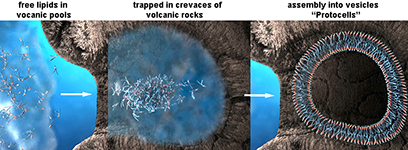

| Protocell Formations and Polymeric Molecules Nature Communications 23 Nov 2020 |

 |
| Protocell compartments, used as models for an important step
in the early evolution of life on Earth,
can be made from short polymers. Protocell compartments
form through liquid-liquid phase
separation. Although they have no membrane
separating them from their environment, the protocells can
sequester RNA and maintain distinct
internal microenvironments. |
|
An important step for the early evolution of life on Earth
is compartmentalization,
thus making synthetic compartments that could function
like protocells out of molecules that were more similar in
size to the molecules that would have been available on
Earth when life is a way of looking at the origin of
cells. |
|
Protocells
are
'complex coacervates' made by combining two oppositely charged polymers
in a solution. The polymers are attracted to each other
and can form droplets through liquid-liquid phase
separation, similar to oil droplets forming in a salad
dressing as it separates. Polymers as short as five units
long could form stable compartments. In a variety of salt
concentrations these protocells were able to maintain an
apparent pH inside that was different than the pH of the
surrounding solution. |
|
When single-stranded RNA molecules were added to the
solution, compartments made from shorter polymers were
better able to sequester the RNA and the RNA molecules
inside the compartments were concentrated by as much as
500 times more than the surrounding solution.
Double-stranded RNA molecules were also sequestered by the
compartments and were more stable in the compartments made
from shorter polymers. The RNAs formed some of its
secondary structure, but did not maintain its fully native
folding inside the compartments. |
|
These synthetic vesiciles capture the essence
of plausible early-Earth molecules and suggest a feasible
for a mechanism of the establishment of cell-like
structure on early Earth. |
|
BACK |